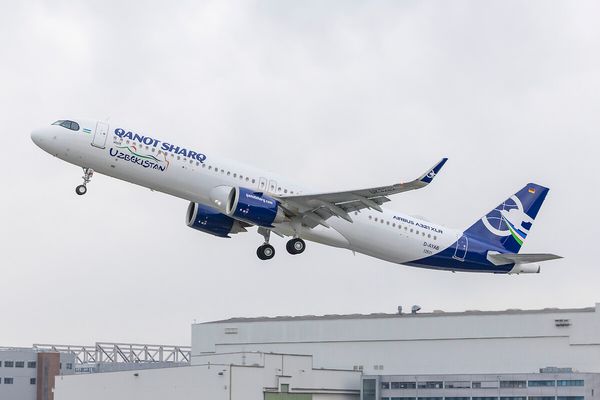
The Commercial Aircraft Corporation of China, COMAC, or the "Dream of a Nation," is referred to by Chinese President Xi Jinping. Founded in 2008, the state-backed Chinese aircraft manufacturer laid out its ambitions to become a global leader in aircraft manufacturing, taking on the likes of industry giants Boeing and Airbus. After successfully developing and launching two aircraft models in the 16 years the company has been in business, the question of whether COMAC is destined for success or failure continues to loom.
COMAC Current Aircraft and Orders
Since its founding, COMAC has launched two aircraft, the ARJ21 and the C919. The ARJ21 is the company's regional jet with both -700 and slightly larger -900 variants. Both the ARJ21-700 and ARJ21-900 tout a standard range of 1,200 NM (2,200 km) and 2,000 NM (3,700 km) and 1,800 NM (3,300 km) for the extended range of -700 and -900, respectively. The main difference between the two ARJ21 variants is in seating capacity, with the ARJ21-700 seating 90 passengers and the ARJ21-900 seating 15 more.

COMAC's other product, the C919, was developed as a competitor to Boeing's 737 and Airbus' A320 families. The China COMAC aircraft C919 has an advertised range of 2,200 NM (4,100 km) for the standard version and 3,000 NM (5,600 km) for the extended-range variant. The aircraft seats between 160 and 190 passengers, depending on the cabin configuration.
Both aircraft have amassed an impressive number of orders for brand-new airplanes. As of March 2024, the ARJ21 has 345 orders, 20 options, and 134 deliveries. On the other hand, the China COMAC aircraft C919 has 933 orders, 120 options, and only five deliveries. While the COMAC C919 does only have five deliveries, it has received tremendous support from China's big three airlines, with China Southern and China Eastern (the launch customer for the C919) [https://aeroxplorer.com/articles/china-eastern-airlines-receives-second-c919-aircraft.php] each placing an order for 100 standard aircraft and Air China ordering 100 of the extended range variant.

COMAC's Expansion
Earlier this month, COMAC made headlines on two different expansion plans. On May 14, 2024, the company announced plans to expand its main assembly plant at Shanghai Pudong International Airport (PVG). The $1.65 billion (RMB 11.955 Billion) project will add 330,000 square feet (30,658 square meters) of factories, warehouses, and aprons to COMAC's existing site. The expansion will help meet COMAC's plans to output 150 COMAC C919 annually by 2028.
In addition, the company is reportedly developing two long-haul aircraft, the C929 and the C939. The C929, originally developed with Russian manufacturer United Aircraft Corporation (UAC) but taken over by COMAC after the Russian invasion of Ukraine, is designed to be an alternative to Boeing's 767 family and Airbus' A330 series. The company advertises a range of 6,400 NM (12,000 km) with seating for 260 to 290 passengers in a two-class configuration.

The more recently announced C939 would be slated to compete with Boeing and Airbus' flagship jets, the B787 and B777X, if ever delivered, and the A350. Few details have been revealed about the C939 project, but COMAC has stated it expects the aircraft to have a capacity of around 400 passengers and a range-topping 7,000 NM (13,000 km). If COMAC can successfully develop and launch these two wide-body aircraft to international customers, it would shake up the look of modern commercial aviation.
Challenges China COMAC aircrafts C919 and ARJ21 Faces
A challenge to international expansion for the ARJ21 and the C919 is that neither aircraft has been certified in major aviation markets outside China. In addition, while over 100 ARJ21 models have been delivered to customers, only four C919 aircraft have been delivered, raising the question of whether COMAC is ready to compete directly with Boeing and Airbus.
If certified, the China COMAC aircraft C919 would offer airlines worldwide an alternative to Boeing and Airbus' narrow-body aircraft, especially as Boeing navigates the many issues facing the B737-MAX family. However, airlines would have to invest significant capital in pilot and crew training on an entirely new aircraft manufacturer, posing an economic challenge to many airlines.

From an environmental standpoint, the COMAC C919 is much less efficient than Boeing or Airbus. Made from 80% steel and duralumin and only 12% by weight composite compared to some of Boeing's airframes, the C919 is much heavier than other options. As a result, the Chinese aircraft burns 10% more fuel per seat than the Airbus A320neo.
While COMAC faces many challenges before it can successfully compete with Airbus, Boeing, and other large aircraft manufacturers internationally, the company offers an appealing alternative to Chinese operators, primarily as the country works to reduce its reliance on Western aviation technologies.
The Future of COMAC
COMAC and the development of Chinese-produced aircraft fit with China's larger industrial strategy to increase reliance on domestic products over imports, especially in the aviation industry. With the current Geo-political climate, China wishes to avoid the problems faced by the Russian aviation sector as a result of Western sanctions [https://aeroxplorer.com/articles/russia-has-spent-12-billion-to-keep-its-aviation-sector-alive-amid-western-sanctions.php]. By moving the production of aircraft into the domestic sector; China hopes to safeguard its aviation industry.

However, neither the COMAC C919 nor the ARJ21 are manufactured without Western materials. The only engine available for the C919 is the Leap X1C engine produced by CFM International, a joint American and French engine manufacturer. While the Aero Engine Corporation of China (AECC) is working on a CJ-1000A engine which COMAC hopes to power the C919 by 2030, that technology is still years away, forcing COMAC to rely heavily on Western imports for the most crucial part of an aircraft, its engine. Engines are not the only things for which COMAC relies on international suppliers. Nearly every part of the C919, from its interior to avionic displays, is manufactured in other countries. If the company truly wants to be 100% Chinese-made, it must find alternatives to foreign goods.
As China looks to become the largest aviation market by 2030 or 2040 [https://aeroxplorer.com/articles/china-could-become-the-worlds-largest-aviation-market-following-c919-release-experts-say.php], a vision supported by both Boeing and Airbus, COMAC will play a vital role in the expansion of the Chinese aviation industry. Boeing predicted that China would account for 20% of global air travel demand through 2042, requiring over 8,500 new aircraft, presenting an incredible domestic market for COMAC. However, to truly compete with Boeing and Airbus, the company would have to overcome the regulatory challenges faced in international markets and convince airlines to invest in their products over those offered by Boeing or Airbus.
Austrian Airlines Abruptly Terminates Wet Lease with Braathens Regional Airlines » EASA Mandates Airbus A320 Fuselage Inspections » Air Canada Rouge to Launch Boeing 737 MAX 8 Operations »
Comments (0)
Add Your Comment
SHARE
TAGS
INFORMATIONAL Chinese Aviation COMAC C919 China COMAC ARJ21RECENTLY PUBLISHED
 Should Students Have Homework? Better After-School Balance
Is homework bad for students? Explore learning benefits, stress, sleep, and smarter workload limits, so after-school time stays balanced.
STORIES
READ MORE »
Should Students Have Homework? Better After-School Balance
Is homework bad for students? Explore learning benefits, stress, sleep, and smarter workload limits, so after-school time stays balanced.
STORIES
READ MORE »
 Air Canada Rouge to Launch Boeing 737 MAX 8 Operations
Air Canada has officially confirmed a strategic shift for its leisure subsidiary, Air Canada Rouge, announcing that Boeing 737-8 (MAX 8) operations are slated to begin in late Q1 2026. The move marks the beginning of an ambitious year-long transition that will see Rouge evolve into an all-Boeing 737 operator.
ROUTES
READ MORE »
Air Canada Rouge to Launch Boeing 737 MAX 8 Operations
Air Canada has officially confirmed a strategic shift for its leisure subsidiary, Air Canada Rouge, announcing that Boeing 737-8 (MAX 8) operations are slated to begin in late Q1 2026. The move marks the beginning of an ambitious year-long transition that will see Rouge evolve into an all-Boeing 737 operator.
ROUTES
READ MORE »
 Qanot Sharq Takes Delivery of First Airbus A321XLR to Transform Central Asian Long Haul Travel
Uzbekistan’s premier private carrier, Qanot Sharq, has officially taken delivery of its first Airbus A321XLR. The delivery, which took place today at the Airbus facility in Hamburg, makes Qanot Sharq the launch operator for the ultra-long-range narrow-body in the Commonwealth of Independent States (CIS) and Central Asia.
ROUTES
READ MORE »
Qanot Sharq Takes Delivery of First Airbus A321XLR to Transform Central Asian Long Haul Travel
Uzbekistan’s premier private carrier, Qanot Sharq, has officially taken delivery of its first Airbus A321XLR. The delivery, which took place today at the Airbus facility in Hamburg, makes Qanot Sharq the launch operator for the ultra-long-range narrow-body in the Commonwealth of Independent States (CIS) and Central Asia.
ROUTES
READ MORE »



